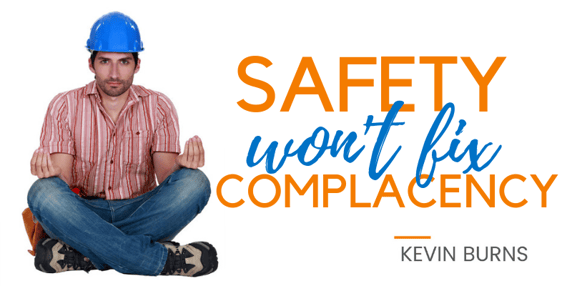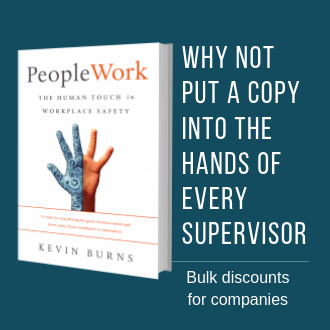Safety Won't Fix Complacency

Perhaps your company was doing great from a safety performance standpoint and then suddenly, you had an incident. As a reaction, you double-down on safety process and procedure: have more meetings, enforce the rules more, have more inspections. You know, the usual suspects. Maybe even hire an outside safety speaker to turn up the volume on safety. Your immediate thinking might be that somehow the collective eye of the company was taken off safety for just a moment when it all went south. And now, you feel that you’ve got to get the focus back on safety.
Since the problem seems to be safety, the thinking goes, then the solution must be more safety. But nothing could be further from the truth. Safety isn’t the problem. Your safety protocols work. Safety procedures have been tested and passed. Rules and regulations have been discussed with employees ad nauseum. You've never had a better safety program. It works exactly the way it is supposed to.
Well then, complacency must have somehow infiltrated the safety program, you might be thinking. If you can fix the complacency, then you can fix the problems that create the incidents in safety.
That’s the traditional, linear thinking. And if only it worked that way. But, that’s not entirely where the problem exists. Besides, safety complacency isn’t fixed from the safety side. It’s fixed from the engagement side. So now you are asking how you do that from your front-line position? Read on and watch the video below.
Engagement is the culprit
Gallup polling for the last ten years has pegged the disengagement rate of employees at about 70%. Expecting those 7 out of 10 employees to be fully engaged in safety when they're not engaged in the job seems a little misguided.
If you want to fix safety performance, fix the engagement problem first. And here is the conundrum: the safety department may be responsible for safety but who is responsible for engagement? (Feel free to mistakenly point your fingers at Human Resources here – nice try but, no.)
Deep down, you know that a disengaged workforce is not engaged in safety. But how can you tackle the engagement problem when you can’t even really describe how it happens?
How we create disengagement
Disengagement can have a host of causes but let's take a look at the most often-quoted. Think about a time when you felt unappreciated. It could be at work, at home, a volunteer position or even helping a family member (and you know how ungrateful some of them can be). When you feel unappreciated, you lose your motivation. Your heart isn’t in it anymore and you check out of what you are doing. That’s disengagement.
Part of what is fueling disengagement is technology. Old-school, face-to-face communication has been replaced by teleconference communications and email. The technology that is supposed to bring us closer together is, in many regards, isolating us more. The more we rely on technology to communicate for us, the less we are becoming willing to actually speak to people, in person. That has encouraged disengagement to rise. Technology may be a useful tool for facts, but it is a lousy communicator of emotion. You struggle to establish the “tone” of what is being said through email and text message. Without voice inflection, eye contact and gestures, there is little context for what is meant by the words in your email.
Now, let’s take that to appreciation. It is impossible to communicate in a meaningful way how much someone is appreciated or to make people feel valued through email and text. Oh, you can certainly communicate that they are doing a good job, but there is no “tone” or "energy" attached to it.
Reciprocity may help stimulate engagement

People love to be appreciated. When it happens, we want it to continue. To fuel that, there is something called reciprocity that happens to us. Business guru and speaker, Brian Tracy, talks about the Law of Reciprocity: when people do nice things for us, we feel the need to do nice things for them.
When someone buys you a lunch, you feel like you need to buy the next lunch. When someone offers you a compliment, you feel obliged to say something nice in return. When someone holds a door open for you, you want to hold the next door open for them. You say thank you. They say thank you. You want to reciprocate their good deed. That’s reciprocity.
People want to reciprocate that which is done to them. If you appreciate my effort, I will give you more of that same effort. And reciprocity works the other way too. Do something unkind to someone and they will want to reciprocate an unkind gesture. If you don't appreciate good work, you will find that people start holding back on the effort level. No one likes to go to work or to give their best effort if no one appreciates it. They’ll just give enough to stay out of trouble but not much more.
The hard part (you're gonna hate it)
The more that people are appreciated for the work they do, the more likely they are to engage in their work. Engagement is the antidote to complacency. If you want to battle safety complacency long-term, stop focusing on safety short-term. Focus on appreciation.
Appreciation is the icky, gooey, feel-good, soft stuff that makes us so nervous because it involves, ugh, feelings. But you cannot communicate the true level of appreciation through any other means than face-to-face, one-on-one communication. That’s where you connect with your people. That’s where you can tell them how important they are to the team and that you find it easier with them on the team. If you want your people to play a strong role on the team, tell them how important each of them are to the team. (Seriously, it's not that hard.)
Your people need to hear your appreciation but more importantly, they need to feel it. If you want your team to engage in safety, it works better when you engage in helping them to feel your appreciation. That only happens in the one-on-one, face-to-face meetings. Put away your Powerpoint deck and your phone. Connect with your people in a meaningful way.
Kevin Burns, consultant and author, works with smart, caring companies to energize safety culture, build teamwork, and get employee buy-in. Kevin is on a mission to help employees purposefully care about the work they do and to actively look out for the people they do it with. He is the author of, PeopleWork: The Human Touch in Workplace Safety – the book that is changing how companies do safety. He is based in Calgary, Alberta.


